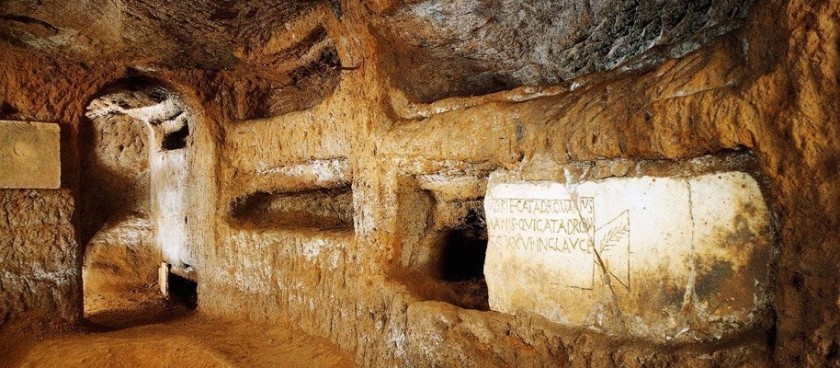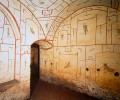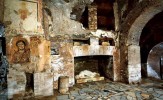- #IT19
- +3906.78.50.350
- info@catacombe.org
- http://www.catacombe.org/
- Working hours*:
Tuesday to Sunday
9:00 to 12:00 and 14:00 to 17:00. - Prices*:
Adults: 8€
Children (less than 15): 5€
Includes a guide in English - * - opening and closing times as well as entrance prices, are subject to alterations without notice. Visitors are advised to check before visiting.
- 41.8558030, 12.5158500 Copy to clipboard Copy
-
#Catacombs
The catacombs are subterranean passageways that were used as place of burial for a number of centuries. The burials of Jewish, pagan and early Christian Roman citizens in the catacombs began in the second century and ended in the fifth century.
The word catacomb, which means "next to the quarry", comes from the fact that the first excavations to be used as a place of burial were carried out in the outskirts of Rome, next to the site of a quarry.
The reason for the catacombs
The Christians did not agree with the pagan custom of burning the bodies of their dead, for which reason to solve problems created from a lack of space and the high price of land they decided to create these vast underground cemeteries.
The catacombs possess a huge number of subterranean passageways that form real labyrinths that are several kilometres long, along which rows of rectangular niches were dug out.
The corpses were wrapped in a sheet and placed in the niches, which were then covered with gravestones made of marble or, more commonly, baked clay. Subsequently, the name of the deceased was carved on the cover accompanied by a Christian symbol.
Roman law at the time prohibited the burial of the deceased in the interior of the city, for which reason all of the catacombs were located outside of the walls. These separated and hidden places below ground constituted the perfect refuge in which the Christians could bury their own, freely using Christian symbols.
The end of persecutions
On signing the Edict of Milan in the year 313, the persecution of Christians ceased, and they could begin to build churches and acquire land without fear of confiscation. In spite of this they continued to use the catacombs as cemeteries until the 5th century.
During the barbarian invasion of Italy in the 8th century many catacombs suffered continuous lootings, for which reason the Popes caused the still remaining relics to be transferred to the city's churches. After these transfers, some catacombs were abandoned completely and forgotten for centuries.
Catacombs of Rome
In Rome there are more than sixty catacombs made up of hundreds of kilometres of underground passageways that hold thousands of tombs. Currently only five of them are open to the public:
1. Catacombs of San Sebastiano (Via Appia Antica, 136): These 12 kilometre long catacombs owe their name to San Sebastiano, a soldier who became a martyr for converting to Christianity. Together with those of San Callisto they are the best that can be visited. Opening times are Monday to Saturday from 9:00 to 12:00 and from 14:00 to 17:00.
2. Catacombs of San Callisto (Via Appia Antica, 126): With a network of passageways over 20 kilometres in length, the tombs of San Callisto were the burial place of 16 pontiffs and scores of Christian martyrs. Opening times are Thursday to Tuesday from 9:00 to 12:00 and from 14:00 to 17:00.
3. Catacombs of Priscilla (Via Salaria, 430): These hold some frescoes that have great importance for art history, such as the first representations of the Virgin Mary. Opening times are Tuesday to Sunday from 9:00 to 12:00 and from 14:00 to 17:00.
4. Catacombs of Domitilla (Via delle Sette Chiese, 280): Discovered in 1593, these catacombs, which are more than 15 kilometres in length, owe their name to the granddaughter of Vespasian. Opening times are Wednesday to Monday from 9:00 to 12:00 and from 14:00 to 17:00.
5. Catacombs of Sant’Agnese (Via Nomentana, 349): After being a martyr because of her Christian faith, Sant’Agnese was buried in the catacombs that subsequently bore her name. Opening times are from 9:00 to 12:00 and from 16:00 to 18:00; the catacombs are closed on Sunday mornings and Monday afternoons.
A walk through the insides of Rome
The catacombs of Rome offer a very special visit in which the funeral remains of those buried many centuries ago can be seen. It is fascinating to travel through the dark and damp passageways, where you can see, in addition to the niches, some inscriptions with the names of the people that once occupied them.
Due to the high infant mortality at that time, you can see a large quantity of spaces prepared for these children, alongside some larger graves in which the whole family was buried.
During the visit, a guide who is specialized in the topic gives the visitors several interesting facts relating to the catacombs and the period in which they were operating. The guided tours are in Spanish and are included in the cost of entrance.


